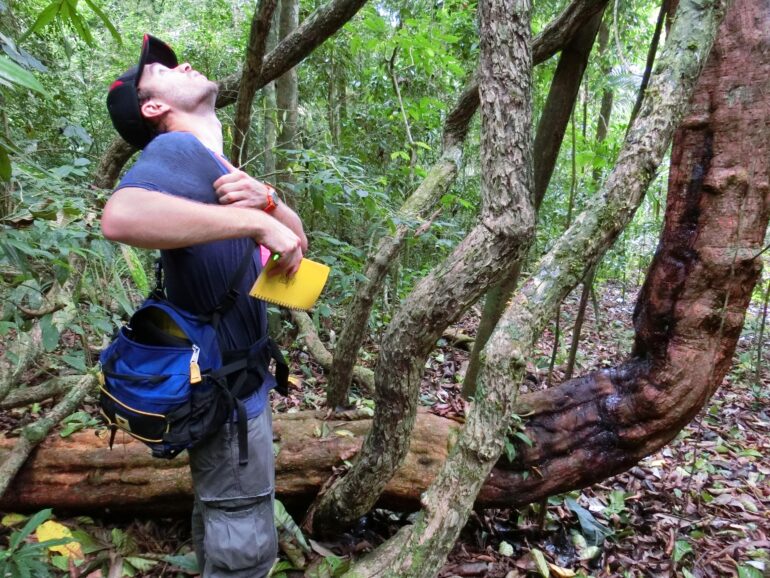Many tropical forests are experiencing increases in lightning and lianas, thanks in part to global change. This one-two punch is likely causing an increase in the death of small trees, which could lead to shifts in composition of tropical forests and their ability to store carbon. A paper in the journal New Phytologist reports on this development.
Tropical forests experience 35-67 million lightning strikes each year, and strikes appear to be becoming more frequent. Evan Gora, the paper’s lead author and a Research Fellow at Cary Institute of Ecosystem Studies, explains, “Lightning is a major cause of tree death and forest disturbance, yet it has been understudied as an agent of change. We wanted to understand why some lightning strikes kill more trees than others—and discovered that lianas play an outsized role.”
Lianas are woody vines with long climbing stems that are common in the tropics. In competition for sunlight, lianas grow up trees and into their canopies. Gora and colleagues found that liana density is positively associated with the number of trees killed and damaged by lightning. The team’s research indicates that this is because lianas—which are highly conductive—serve as a pathway for electrical current to move from large to small trees.
“Large trees are more likely to be struck by lightning,” Gora notes. “When lianas are in the canopy, they amplify the effects of lightning strikes, resulting in more severe damage to neighboring trees. By physically connecting trees that would otherwise be separated, lianas act like jumper cables, delivering deadly electrical current to smaller understory trees that would otherwise survive a lightning strike.”
The research took place in a lowland forest on Barro Colorado Island, Panama, the only tropical forest where lightning impacts have been systematically quantified. Here, it is estimated that lightning kills more than 16% of tree biomass annually, including 40-50% of the largest trees. Past studies found the ecological effects of individual lightning strikes to be highly variable, with the few strikes described ranging from 1-116 trees damaged and 0-65 trees killed.
A novel lightning detection system was used to reveal the mechanisms underlying this variation, and whether the presence of lianas influenced the severity of lightning disturbance. Surveys were conducted on 78 lightning strikes located in areas where lianas had been mapped; 1,921 trees with conspicuous lightning damage were monitored. Tree condition was evaluated within four months of the lightning strike, and up to four times within 23 months post-strike.
For 65 of the lightning strikes, the team identified the source of the electricity to 85% of damaged trees (1,434 of 1,681). These included: (1) physical contact with a liana, (2) physical contact with a tree, (3) flashover from a nearby liana, or (4) flashover from a nearby tree. They then evaluated how forest structure impacted lightning disturbance severity for 22 lightning strikes (569 lightning-damaged trees).
When liana density was high, lightning disturbance was more severe, with more small trees damaged or killed. Large trees (greater than 10 cm) had no associations with forest structure, indicating that lianas primarily transferred electricity to small trees. This was supported by observations of the source of electric current. Physical contact with lianas had a strong positive relationship with the number of trees that were damaged or killed per strike. Liana flashover and tree physical contact also had positive relationships with lightning severity, however, these relationships were weaker than liana physical contact.
Lianas did not increase the area or footprint damaged by lightning, but they increased the severity of lightning disturbance to neighboring trees. Gora explains, “Lianas appear to move electricity from large trees to smaller understory trees, with our field observations indicating that small trees are damaged and killed more frequently when liana density is high and trees have direct contact with the vines.”
The authors caution that there could be a positive feedback loop in forests where liana density is especially high, such as seasonal and young tropical forests. Lianas make lightning disturbance more severe, potentially leading to deeper canopy gaps that then become hotspots for liana regeneration, which in turn amplify the severity of future lightning strikes. This positive feedback loop could have major implications for the dynamics of liana-tree competition and forest carbon budgets.
Gora concludes, “Lianas and lightning, two understudied phenomena that are sensitive to global change, interact to shape tree survival. More work is needed to identify the tree species that will be most impacted, those that will be resilient, and how this will ultimately change forest composition and carbon storage over time.”
More information:
Evan M. Gora et al, Lianas increase lightning‐caused disturbance severity in a tropical forest, New Phytologist (2023). DOI: 10.1111/nph.18856
Provided by
Cary Institute of Ecosystem Studies
Citation:
In the tropics, woody vines may make lightning more deadly for forests (2023, March 27)



